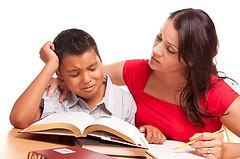Reading problems will plague a person throughout their life. It carries with it low self-esteem and ridicule, makes others look at you as if you are mentally slow, and can prevent you from getting a driver’s license or a good paying job. Difficulty reading does not mean you are handicapped, it simply means someone has not taken the time with you to teach you how to read so your brain can comprehend the material.
A survey conducted by The National Institutes of Health estimates that the percentage of the general population with learning disorders ranges from 5%—15%. About 80% of these people have some sort of learning disorder have reading disorder, the most common being dyslexia. Dyslexia usually includes problems with spelling and writing as well. Other studies suggest that about 4% of school age children have a reading disorder.
A reading disorder could produce poor comprehension, reversal of words or letters while reading, and difficulty decoding syllables or single words, or the ability to associate letters with specific sounds (phonics). Reading disorders often are inherited, so children with this problem will often have a parent who also suffers from it.
Those with reading problems will often fall behind in school, and usually perform poorly on standardized tests, even though they are often well above average in intelligence. It is a problem that can often go undetected, especially in the past, and those suffering may feel they have to hide their problem. Some adults, especially the extremely bright ones, have been able to get away with disguising their handicap for years, working a menial job and using creative resources to escape being detected. They view a reading problem as something to be ashamed of, and not a malfunction in the brain that can be corrected.
Reading is a complex brain function. Problems in any of these areas could be cause for concern, and a sign to get some professional help:
- Difficulty in eye coordination when following printed lines
- Spatial orientation to interpret letters and words
- Visual Memory that retains the meanings of letters and words by sight
- Inability to grasp grammar or sentence structure
- Inability to analyze and put things into categories
- Associating visual cues and memory with specific sounds
In order to diagnose reading problems a professional examiner must take into account the person’s age, intelligence, educational opportunities, and such cultural factors as whether the language spoken at home is different from the language taught and used at school.
Boys seem to have the most problems, accounting for approximately 60%-80% of children with reading disorders. This could indicate that it is more common in boys, or that girls with reading disabilities are simply not being diagnosed correctly. Diagnosis is complicated by the fact that 20%—55% of children with reading disorder have attention-deficit/hyperactivity disorder (ADHD), a behavioral disorder that aggravates learning difficulties and conduct problems (usually associated with boys).
The American Academy of Ophthalmology, the American Academy of Pediatrics, and the American Association for Pediatric Ophthalmology and Strabismus have issued a policy statement warning against visual treatments and recommending a cross-disciplinary educational approach that would include:
- Phonics based study — based on sound/symbols that break words down into the letters and the sounds associated with them.
- Mental associations that stimulate multi senses – visual, auditory and kinesthetic channels. The student sees, feels, and says the sound-symbol association at the same time. (Example: a student may use his/her finger to trace the letter or letter combination while pronouncing the letter or word aloud.)
- Repetitive drill and practice through highly structured remediation serves to form necessary associations between sounds and written symbols.
For the most part, those with reading disabilities can be treated successfully, especially if the condition is diagnosed early. In the past, instead of looking to a problem with reading, schools have placed students in remedial or special education, and the problem continued and became worse due to frustration. A support system of family, friends and teachers, will work wonders for improving performance and self-esteem. It is not a disease, nor is it something to be ashamed of. Many famous and successful people have problems reading, and have learned to adapt and overcome them.
About the author:
Ron White is a two-time U.S.A. Memory Champion and memory training expert. As a memory keynote speaker he travels the world to speak before large groups or small company seminars, demonstrating his memory skills and teaching others how to improve their memory, and how important a good memory is in all phases of your life. His CDs and memory products are also available online at BrainAthlete.com.
Sources:
Society for Neuroscience — Reading Failure: http://www.sfn.org/index.aspx?pagename=brainBriefings_reading_failure
Reader’s Digest — The Boy Who Couldn’t Read, September 2005, pgs. 72A-72F.
Encyclopedia of Mental Disorders — Reading Disorder: http://www.minddisorders.com/Py-Z/Reading-disorder.html




